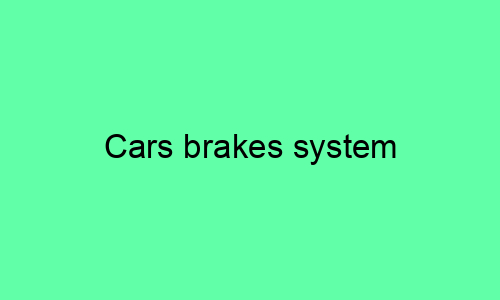Car Brakes System
Introduction
The brakes are one of the most important safety features on a car. They allow you to slow down or stop your car in a controlled manner, and they help to prevent accidents.
There are two main types of brakes: disc brakes and drum brakes.
Disc Brakes
Disc brakes are the most common type of brake on modern cars. They consist of a metal disc that is attached to the wheel hub. When you press the brake pedal, a caliper squeezes the disc, which slows down or stops the wheel.
Advantages of Disc Brakes
- More powerful than drum brakes
- Less likely to fade in high-temperature conditions
- More resistant to water and dirt
- Easier to maintain and repair
Disadvantages of Disc Brakes
- More expensive than drum brakes
- Can be noisy
- Can be prone to squealing
Drum Brakes
Drum brakes are a less common type of brake that is still used on some older cars. They consist of a metal drum that is attached to the wheel hub. When you press the brake pedal, shoes press against the inside of the drum, which slows down or stops the wheel.
Advantages of Drum Brakes
- Less expensive than disc brakes
- Quieter than disc brakes
- Less prone to squealing
Disadvantages of Drum Brakes
- Less powerful than disc brakes
- More likely to fade in high-temperature conditions
- More susceptible to water and dirt
- More difficult to maintain and repair
How to Choose the Right Brakes for Your Car
The type of brakes that you choose for your car will depend on a number of factors, including the make and model of your car, your driving habits, and your budget.
If you drive a high-performance car or you frequently drive in mountainous areas, disc brakes are a good choice. They are more powerful and fade-resistant than drum brakes.
If you drive a smaller car or you are on a budget, drum brakes are a good option. They are less expensive and quieter than disc brakes.
Brake Maintenance
It is important to have your brakes inspected regularly by a qualified mechanic. They will be able to check for worn pads or shoes, and they can make sure that your brakes are functioning properly.
You can also do some basic brake maintenance yourself. Here are a few tips:
* Check your brake fluid level regularly. The fluid should be between the “min” and “max” marks on the reservoir.
* Inspect your brake pads or shoes for wear. If they are less than 1/4 inch thick, they should be replaced.
* Listen for any squealing or grinding noises when you apply the brakes. These noises could indicate a problem with your brakes.
By following these tips, you can help to ensure that your brakes are always in good working order.






